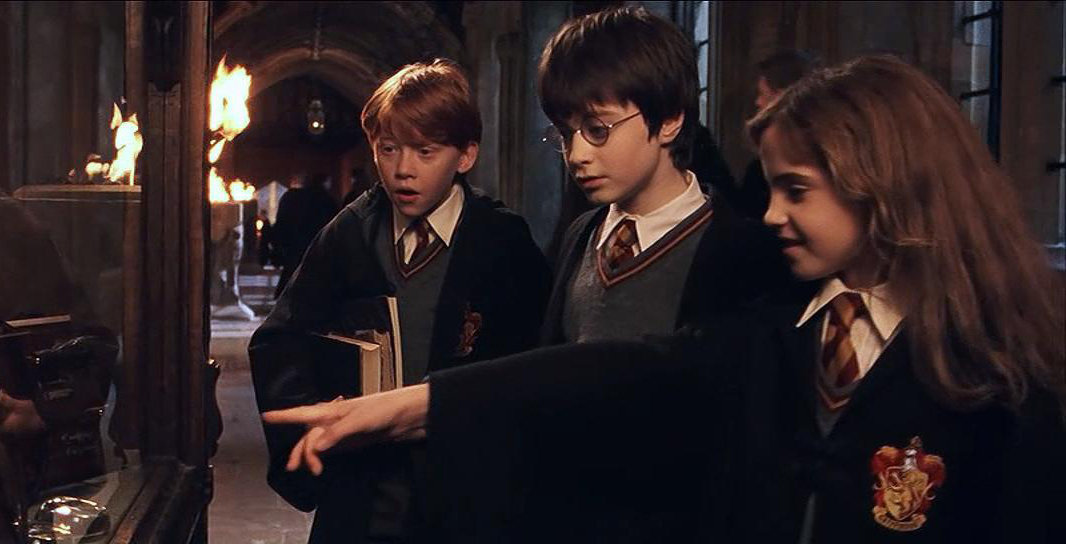Throughout the month of December, I am going to watch and critique all eight “Harry Potter” films. Since this franchise has been around since the late 1990s, it has accumulated quite a fanbase and naturally, there may be some disproval from my reviews. So, let me shed some light on my relationship with the franchise. I have not read any of the books and will solely focus on the films and their cinematic elements. Also, this is my second time watching the series; the first time was one year ago. While I know the entire story, I will be reviewing each film as if it is my first time watching it and only build off the previous films.
The Beginning of a Fantasy Sensation
“Harry Potter and the Sorcerer’s Stone” (2001) begins not with Harry Potter, but with Albus Dumbledore, who bears a striking resemblance to Gandalf the Grey, both physically and intellectually. Dumbledore magically removes the light from the streetlights with the power of his wand and a flick of his wrist. Then, as a cat transforms into a witch and an eight-foot giant with a baby (later to be known as Harry Potter) flies down on a motorcycle, I quickly realized how unusual and magical this film is. Then, as no surprise to cinephiles who love the fantasy genre, the film flash-forwards to present day (in this case, nearly 11 years later).
Harry Potter, who has many sobriquets including “the boy who lived” and “the boy under the staircase,” is nearly 11 years old living with his mentally abusive aunt, uncle, and cousin. Within a few minutes of being introduced to this horrific family, they go to the zoo; there Harry unintentionally performs some magic as unbeknownst to him, his emotions (especially his anger) cause his powers to wreak havoc on those around him.
Throughout the film, Harry learns that he is a wizard, attends Hogwarts School of Witchcraft and Wizardry, befriends two students, Ron Weasley and Hermione Granger, continuously stands up to the school bully Draco Malfoy, and meets Professor Severus Snape and Headmaster Albus Dumbledore. (*Spoilers*) In the end, Harry is quite brave and quick on his feet as he defeats Professor Quirrell and Voldemort (the man who killed Harry’s parents and magically lives off Professor Quirrell’s head) and saves the philosopher’s stone, which produces an immortality potion. The film ends just as Harry’s first year at Hogwarts ends as he boards the train to go back “home” to his abusive family for the summer.
Turning a Hit Book into a Hit Film
Director Chris Columbus, producer David Heyman, and writer Steve Kloves had an extremely difficult task: produce a film that had a cohesive narrative that simultaneously served as an exposition to the entire franchise where some questions would not be answered until eight films later.

While some could say that making a film based on a book is relatively easy, I’d beg to differ. Columbus and Kloves had to take an international bestseller over 300 pages long and condense it into a 2 1/2 hour long film. They had to utilize both practical and visual effects to create a world where magic seemingly exists. With a book, anything goes since it’s all in the reader’s imagination. However, a film is a collaborative artform where showing is believing. The crew had to build an entire world that somehow pleased all readers (even though every reader had their own idea on how the wizarding world looked) and was practical in terms of the film’s budget and “movie magic.”
From the unique and colorful sets and costumes to the hundreds of extras, Columbus and the rest of the crew not only offered audiences an amazing narrative from start to finish, but also gave audiences a great introduction into the wizarding world of “Harry Potter.” My only problem with this film is that Harry went back home to his abusive family in the end, but I assume that the book ended the same way.
“Harry Potter and Sorcerer’s Stone” is available to rent from Amazon Prime, Vudu, Fandango Now, Google Play, iTunes, and Microsoft.